Bringing Home your Border Collie
- Before you pick up your new Border Collie
- Bringing your dog home
- Your dog’s name
- What to expect when you arrive home with your new dog
- The Honeymoon
- Introducing your new dog to your home environment
- Crate training
- Establishing a routine
- Introducing your rescued Border Collie to other dogs in the family
- Socializing your rescued Border Collie
FIRST THINGS FIRST – CONGRATULATIONS!!!
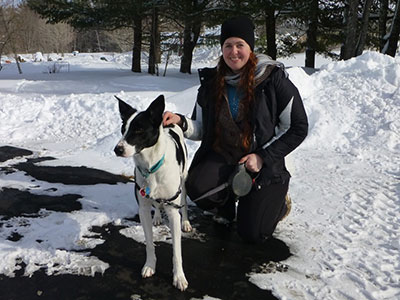
We are all so happy that you chose to help a Border Collie in need and were willing to open your home and hearts to this wonderful breed of dog. The goal of this page is to “SET YOUR DOG UP TO SUCCEED.”
By understanding your new dog’s behavior, you will be able to anticipate problems and correct them calmly and quickly. Be reasonable in your expectations. Above all, be patient, firm and consistent, and use positive reinforcement. We want the adoption of your Border Collie to be a “win-win” situation on both sides!
Before you pick up your new Border Collie
Since you’ve chosen to adopt a Border Collie, you’ve probably educated yourself on the:
1) reasons this breed is unique
2) breed’s behavior characteristics, and
3) changes to your current lifestyle that this dog will cause.
Here at NEBCR, we have compiled a host of information about the breed for your reference. The adoption coordinator that you worked with has shared your Border Collie’s history, veterinary information, evaluations and current routines (i.e. eating, sleeping and activity) so that the transition into your home will be easier. Dogs need structure and are extremely routine oriented. We recommend that you find out all you can about their routine – and duplicate what you can – before you start to reorient him to the rhythms and schedules of your home. Work out your house rules and dog-care regimen in advance among the human members of your household: Who will walk the dog first thing in the morning and last thing at night? Who will feed him? Will your new dog be allowed on the couch or bed? Where will he sleep at night? Will he be crated? All members of your household should agree on these important points of routine.
To ensure a smooth transition, you should already have supplies (a collar, or preferably a harness, ID tag, leash, food, bowls, crate and toys) for your new dog. You should have already lined up a vet, and a training center where you will take your dog for basic obedience. Remember: We believe that all dogs need to be socialized and trained in order to be good citizens. You may be required to enroll in and participate in a basic obedience class with your new Border Collie. If you already have resident pets, make sure they are up-to-date on their shots and in general good health before bringing home your new dog.
Bringing your dog home
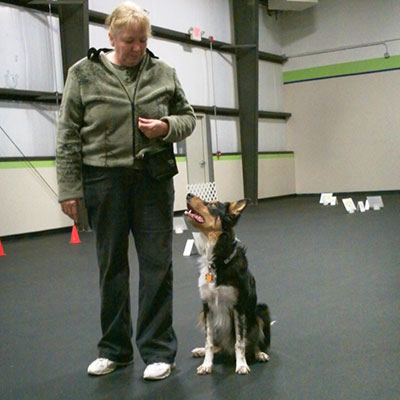
Try to arrange the arrival of your new dog for a weekend, or when you can be home for a few days, for quality, hands-on time. You may wish to set up an appointment with your vet to check out your new dog soon after bringing him home and establish the vaccine schedule, depending on the veterinary care your rescue dog has already received.
Register soon for an obedience class. Don’t ignore this very important step in setting yourself and your rescued Border Collie up for success! We recommend positive reinforcement-based dog obedience classes that teach dog manners, canine good citizenship, and discipline. Try to register for a class that begins 3 to 4 weeks after your dog has come
home with you. It is important that your new dog has some time to adjust to you and your home before putting him into the stimulating environment of an obedience class. Even the shortest “dog manners” course will strengthen the new bond between you and your new Border Collie, provide a valuable face-to-face resource for questions about your dog’s behavior, and serve as a powerful tool for moderating your rescue dog’s less attractive behavior traits. Remember, Border Collies need work. An obedience class is a first step in providing him with active, mental work. The rewards are obvious – what a joy it is to have a well-mannered, trained Border Collie companion!
Your dog’s name
New families often ask about changing the adopted dog’s name. If you desire to, it is fine. It is in no way traumatic to the dog to change his name. New families often ask about changing the adopted dog’s name. If you desire to, it is fine. It is in no way traumatic to the dog to change his name.
What to expect when you arrive home with your new dog
You should expect your new dog to act differently than he did when you met him at the foster home. He will be excited, nervous and possibly tired after the trip to your house. Being routine-oriented, your Border Collie may have just gotten comfortable in his foster home and now recognizes that the routine is changing yet again. He doesn’t know the smells, the sounds, and importantly, the routines and rules of your household.
Dogs may display anxiety and nervousness by: panting, pacing, lack of eye contact, “not listening”, housebreaking accidents, excessive chewing, gastric upset (vomiting, diarrhea, loose stools), refusing food, crying, whining, jumpiness and barking. Your goal in the next few weeks is to reduce noise and confusion, so that he can relax and be calm while adjusting to his new surroundings, routine, and family.
The Honeymoon
All rescue dogs go through a “honeymoon period.” After the first day or so, the dog may be very quiet and extraordinarily controlled and well mannered. Oftentimes, the “real” dog appears two to four weeks later – after he’s figured out the house rules, the daily schedule, and the character of his new family. At this time, he may start testing out his position in the pack, and may “regress” to puppy behaviors and “bad” behavior. Be patient with him, firm in your expectations, and praise him for appropriate behavior.
Introducing your new dog to your home environment
Leash your dog to introduce him to your home. Spend the first 15-30 minutes walking him outside around the perimeter of your yard or the area of your yard that the dog will be in most.
Walk slowly, letting him lead, and let him sniff and pause if he wants to. He is getting used to the “lay of the land” and all the smells associated with his new home. He will likely relieve himself – this is his way of making himself at home by adding his mark to the smells of your home, and now his new home. If you have a place you wish this to happen, encourage him to “get busy” (or use any command you wish) in that area and praise him warmly when he does. The excitement of the move and new family may cause him to have to relieve himself more often than normal. Be prepared to give him plenty of opportunities to do this in the beginning, but also be prepared for the occasional accident in the house at first. Remember, this is a new environment for your dog, and it may take a day or two to catch on to where he is supposed to be eliminating. Some dogs, particularly females, will not relieve themselves for hours, possibly 24 hours, when introduced to a new home. This is not uncommon behavior and you need only be concerned if it goes on longer than a day. Some dogs, particularly males, are confused and will try to “mark territory” in their new home. A firm “No!” (IF you catch him in the act) and taking him immediately to wherever you want him to eliminate, should nip this behavior in the bud quickly. We can’t emphasize enough how much stress and excitement can cause uncharacteristic accidents.
Whenever the rescue dog is not confined, supervise him – set the dog up to succeed! You might want to consider isolating the new dog from your resident dogs during the first 24 hours in your home – he will appreciate the safety and quiet at first as he explores your home. Crate your resident dog or have someone take him for a walk while your new dog explores.
Let the new dog explore the house, but keep the leash on him and make sure he’s supervised AT ALL TIMES! Keeping the leash on allows you a safe, non-threatening way to get your dog or interrupt undesirable behavior. We recommend leaving your new dog on leash in the house for the entire first day. If you have to leave the dog unsupervised, crate him for that period of time. Even in a fenced yard, you’ll want to leave your rescued Border Collie on leash or long line for the first week or so. This way, you can reinforce a recall command and help monitor pack behavior if you have other dogs. Until your new dog bonds to you and makes good eye contact, we recommend leaving him on leash.
Provide quiet time! Quiet time will be important for your new Border Collie in the first week. Due to the stress and anxiety of yet another new environment, he will get worn out faster than usual. Remember, his recent past will have included his previous home/shelter, a foster home, and now another home. Despite your excitement, try to resist inviting friends and relatives over right away. Give him time to get used to your immediate family and resident pets first. If the dog does not solicit play or attention from you, allow him the opportunity to establish himself by giving him his own space. Believe it or not, we don’t want you to force him to play at first!
Crate training
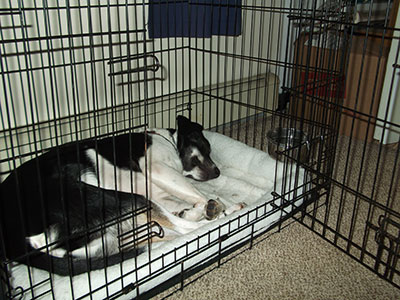
Consider crating your dog. We crate train all Border Collies that pass through our rescue. Every dog needs a place to escape to, a place to call his own, and a crate provides an answer to these needs. Your new dog may show some degree of anxiety when you leave him for work or alone at home. If your dog seems particularly emotional or anxious, try making good-byes and hellos as nonchalant as possible. Crating the dog in the beginning will help him feel safe, eliminate accidents in the house, prevent chewing and other destructive activities, and other behavior that is rooted in nervousness and insecurity. Your dog is safest in the crate when you are not home until you can totally trust them to be loose in the house. This is especially true if you have other resident pets. Even if it appears that the pets are getting along, you might be missing the subtle signs that indicate they are not. Dogs left loose together, particularly before you truly understand what their relationship is, could fight when you are away, resulting in serious injury or even death. Children should be taught to leave the dog alone if he retreats to his crate. Children should never be allowed to release a new dog from his crate unless you are there to supervise. You should never use the crate for disciplining. The crate must be a dog’s sanctuary for crate training to be effective. Many people leave the dog’s crate set up and the door open so that the dog may go in at his own choosing even after he is perfectly trustworthy loose in the house. Crates are great for traveling with your dog, and for getting them used to being crated if they have to spend time at the vet’s office, at the groomer, or in a boarding kennel. Each time your dog is confined, make sure the dog knows he’s a good boy.
While crating a dog helps keep everybody safe, crating should NOT be abused by locking the dog in the crate all the time whether you are home or not. Border Collies need human companionship and should be with you unless they cannot be supervised or trusted alone in the house. For instance, if you are going to shower and the dog still sometimes chews, crate him for those 15 minutes for safety, but then let him out to be with you. If the dog is crated while you are
at work all day, you MUST make an extra effort to let the dog “hang” with you in the house until he is reliably loose in the house.
There is a good chance that your rescued Border Collie will show his insecurity by following you everywhere. This will include trying to follow you to the bathroom, to pick up the mail, and undoubtedly wanting to sleep with you. It is not unusual for him to whine or cry or bark if confined away from you at night – lights out at a new strange place is stressful. If you put the crate close to your bedroom or somewhere he can see you, the problems are usually minimized. Safe chew toys in the crate will give him something to do if he is awake. You might also try covering the crate with a blanket or sheet which sometimes helps calm a dog.
If you prefer not to crate, make sure to create a safe, indestructible space in your home for your rescue dog. Using baby gates in the kitchen, spare bedroom or hallway are common alternatives to using a crate. Consider keeping your dog on “easy clean” flooring at first. If the area of confinement is too large, you may begin to have housebreaking accidents. Pay attention to your dog’s behavior in the confined area – some dogs are more relaxed in the midst of activity (e.g. living room, hallway, kitchen), while others can only relax in secondary areas (e.g. someone’s bedroom, spare bedroom, office). However, an area that is too isolated will likely create anxiety.
Establishing a routine
Try to develop and use a consistent daily routine for feeding, exercising, and bathroom duties. Dogs are creatures of habit, and an established routine creates a sense of security for them. If you do the same things in the same way and in the same order every day, he will settle in more quickly and learn what is expected of him and when.
For example, let your new dog outside as soon as you rise in the mornings. Feed him after a short walk or romp in the yard. Give him another chance to relieve himself before you go to work. Upon return from work, immediately let the dog out for exercise and bathroom break. If he’s exercised heavily, wait 30 minutes or so before the evening feeding. He’ll need another bathroom break anywhere from 30 minutes to several hours after the evening meal, depending on his age – it’ll be your job to figure this out. He should get another outing right before you go to bed.
Introducing your rescued Border Collie to other dogs in the family
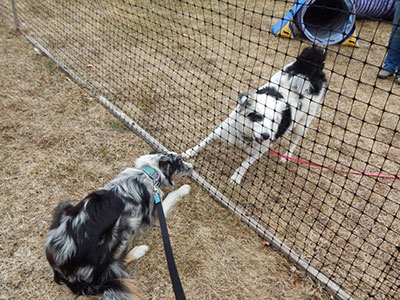
Introductions should be made on neutral territory whenever possible. Have one member of the family bring the resident dog on leash to a nearby fenced park, and you bring the new dog a few minutes later. Dogs are often less “aggressive” to each other if they are not pulling on the leash. Therefore, keep the leash on but do not hold on to it – this provides you a safe method of removing the dogs from each other if tensions run high, or there is trouble. If neutral territory is not an option, your own fenced backyard will do, but definitely do it outside. If the dogs are getting along, let them be together for a while, but only with supervision. If they aren’t getting along, pick up the leashes and separate them, and try again at another time.
Another way to introduce two dogs is “parallel walks”, just getting used to each other but not being able to actually interact. Sometimes dogs that are separated in the house and have a chance to get used to each other from afar, have less difficulty when finally introduced. For others, this only intensifies feelings of discomfort. Depending on your individual dogs, you will have to try out different things to see what works. If you are very lucky, the dogs will hit it off right away, and there will be no problems. Usually, if we know a dog doesn’t get along with other dogs, we will not place that dog in a family with other dogs. Introductions might be best saved for the second or third day. Usually, we encourage people to bring their other dog(s) to the foster home for introductions to the new dog, as this will be more neutral territory, and there will be an experienced person available to help.
If you have other dogs, feed your rescue dog away from them but at the same time. We recommend feeding your new dog in his crate, at least at first, both for his own protection and the protection of your other dog(s).
Socializing your rescued Border Collie
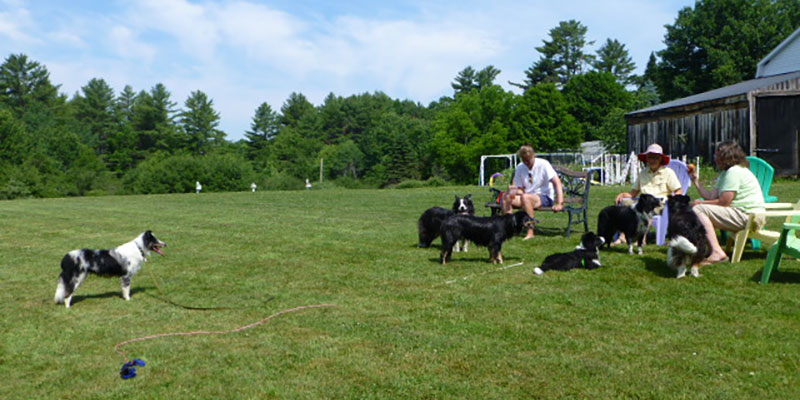
Rescue dogs come from a variety of backgrounds, but all dogs can do with more socialization. AFTER your dog has had time to settle in your home and is starting to look to you with confidence (2-3 weeks), start providing new socialization opportunities.
NOW you can start inviting your friends and relatives over. Do introductions to new people gradually. Introductions can take the form of petting, playing fetch, even going for a walk. Do not force the dog to accept new people – do it positively, with lots of praise, allowing the dog to approach people rather than new people approaching your dog. Be sure to tell your visitors that your dog is new from rescue so they need to be more sensitive. Don’t let them reach for the dog right away– let him come to them. If he does not go to the new person, that visitor should completely ignore the dog and not engage it or make eye contact. This is particularly important for dogs that are reactive to or nervous of strangers. Supply the new person with treats, and at first have them throw the treat in front of the dog and walk by without stopping or making eye contact. The idea is to desensitize the dog slowly to the person, and make them see that meeting strangers has its benefits. Once the dog has met and sniffed the new person, have that person give them a treat directly. After taking several treats from the person’s hand, the dog may be ready to be touched.
Suggest that they pat the side of the dog’s neck or side of the shoulder instead of patting the dog on the top of the head, which can be interpreted by a dog as a powerful dominance attempt, and can be a challenge to some dogs, or frightening to others. Another way to introduce your new dog to strangers, is to go for a walk with them with your dog on a lead. At some point in the walk, hand the lead quietly to the other person and keep walking. Neither of you should pay any attention directly to the dog. Often the dog accepts the person on the other end of the leash as if they were no longer strangers. This of course is not possible with the postman or the electrician, so try to socialize your dog well before meeting these fleeting strangers. Also, keep in mind that most dogs bark at strangers, and some dogs even at people they know, who come to the door. Don’t overreact to this behavior. It is not necessarily a sign of aggression.
To continue your dog’s socialization, start taking him to new places, nearby parks, dog-allowed beaches, and especially to obedience classes! The opportunity will allow you to determine how your dog responds to strange people, dogs and places, and the more people and other dogs he is exposed to, the more socialized he will become.
Finally, above all, be patient, firm and consistent with your new Border Collie. Use positive reinforcement and lots of praise when he’s good. When mistakes are made, correct him when it’s happening, and praise him when he modifies his behavior. Undoubtedly you will get lots of advice – good and bad – from other dog owners! Read and research as much as you can to prepare yourself. Understand that sometimes you may need to try more than one approach to a problem because every Border Collie is different. If someone suggests a method that they “guarantee” will work, but just feels wrong to you, or results in your dog’s behavior worsening, or in them shutting down emotionally – STOP! Go with your gut instinct, and pay attention to what your dog is telling you.
Don’t be afraid to ask questions of the person you adopted your dog from, bring up new situations, and share feelings of frustration that you may have. We follow-up on the dogs we place. We are backed up by people who are experienced in dog behavior and health issues within our own organization, so if we don’t know the answer to a problem, we will ask others. Our goal is to make sure rescue dogs never have to be uprooted again, so we are quite committed to helping you troubleshoot any problems before they become big problems that threaten the placement.
We hope you will enjoy your new Border Collie for years to come and share with us their positive stories as well.